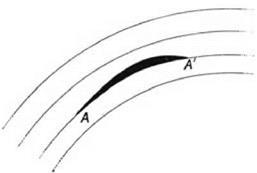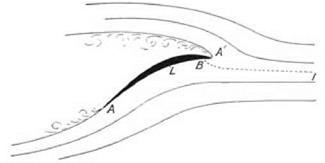Greenhill’s Lectures at Imperial College
Greenhill’s contribution was not confined to the daunting R&M 19. As well as working on the mathematics of gyroscopes and problems of airship stability, in 1910 and 1911 he gave a series of lectures at the Imperial College of Science and Technology. The course was published a year later in a book titled The Dynamics of Mechanical Flight.21 Greenhill explained that the lift of a wing depended crucially on “the opening out of the stream lines” (40) behind the wing. This occurrence would be the expected effect of the surfaces of discontinuity enclosing the “dead” air region above and behind the wing. Greenhill went on to contrast the truth, as he saw it, of the picture of discontinuous flow with the error of certain popular conceptions about the flow of air over a wing. (The two different ideas of the flow are represented in figs. 13 and 14 in his book.) The passage in which he contrasts them is a revealing one: “A popular figure of the stream lines past a cambered wing as here in Fig. 13, showing no such broadening, would imply at once to our eye an absence of all thrust and lift; the figure should be more like Fig. 14” (41). The diagrams to which Greenhill was referring are shown as my figures 3.4 and 3.5 (with Greenhill’s numbering identified in the captions).
Greenhill’s second diagram that was meant to describe the correct flow indicates turbulence in the “dead” air, though his mathematical analysis does not make provision for this. The embellishment seems to be a concession to
|
figure 3.4. Greenhill’s figure 13. Greenhill referred to this figure as a popular, but erroneous, conception of the flow of air over a wing. He argued that it would generate neither lift nor drag. From Greenhill |
1912, 41.
|
figure 3.5. Greenhill’s figure 14. This figure represented Greenhill’s conception of the correct picture of the airflow over a wing, which corresponds to discontinuous Rayleigh flow. From Greenhill 1912, 41. |
Kelvin. We know why Greenhill believed that there was lift in the case of the discontinuous flow, because of the reasoning set out by Rayleigh, but why was it obvious to Greenhill’s eyes that the popular flow picture, my figure 3.4, would be devoid of all thrust and lift? The reasoning may have been that without surfaces of discontinuity, the flow must have the character of the original, continuous flow of an ideal, frictionless fluid—with the “paradoxical” result of zero-resultant force. It looks as if Greenhill took the diagram of smooth, streamlined flow over a wing to imply that the air was being treated as a continuous, ideal fluid in irrotational motion. In other words, it was taken as a flow in which there would be no resultant and where d’Alembert’s paradox would be applicable.
If this was the reasoning, then two significant details of Greenhill’s first drawing were wrong. The flow is not pictured accurately at the leading or trailing edge. The front stagnation point should be below the leading edge, while the rear stagnation point should be on the upper surface of the wing in front of the trailing edge. Instead the air is shown coming away smoothly from the trailing edge itself. Greenhill would certainly have noticed this error, and he gave the correct form of the diagram for a flat plate on page 47 of his book. He presumably put the inaccuracy down to the approximate character of the “popular” representation, as he had in an earlier criticism of drawings of leading-edge flow (22). In any event, he seems to have taken the popular diagram as an attempt to depict the kind of idealized, continuous perfect fluid flow where, as any mathematician would know, all the forces (except the turning couple) canceled out.
Although Greenhill made more effort in the book than in the ACA report to bring real aircraft into the discussion, it was still full of examples and mathematical technicalities of questionable relevance. Predictably, it did not go down well with the practical men. The anonymous reviewer for Aeronautics, who had apparently attended the lectures, said the book confirmed the earlier impression that the calculations were really aimed at providing a diverting recreation for the mathematical mind. “Practical value they lack wholly; the data on which Sir George Greenhill’s mathematical excursions are based are theoretical without fail.”22
G. H. Bryan’s review was very different.23 Up to the present, said Bryan, there had been a lack of understanding about the role of mathematics in aeronautics. The subject has failed to attract our best mathematicians, while “practical men” make claims “in utter disregard for the fundamental principles of elementary mathematics and physics” (264). Under these “chaotic conditions” it would be useful to have a work “by so reliable a mathematical authority” as Greenhill (265). Bryan acknowledged the presence of drastic simplifications involved in Greenhill’s approach but insisted that, in spite of these shortcomings, “the theory of discontinuous motion affords the best opening to the study of pressures on planes from the mathematical standpoint” (266). He listed the “great mathematicians” who had developed the theory, but noted that it had only been applied to flat plates and not yet to bent or cambered planes (which would make better models of the aerofoils in practical use). Some calculations of this kind, the reader was told, were now under way. Bryan did not once ask if the theory of discontinuous flow gave empirically adequate answers. Rayleigh, of course, knew that, as the theory stood, it did not give the right answers, and so did his experimentally inclined colleague Mallock. I now turn from the mathematical to the experimental study of discontinuous flow to see how matters were carried forward on this front.












